Gap
This Gap is about a tool that supports a trainer in having all the devices needed for the training (pen, marker, iphone, A4/letter sized notes) at their disposal whenever needed.
Primary User Needs
The primary user needs are:
3 Prototypes for winning concepts of last week
(the three chosen ones). For all concepts see assignment week #3
This Gap is about a tool that supports a trainer in having all the devices needed for the training (pen, marker, iphone, A4/letter sized notes) at their disposal whenever needed.
Primary User Needs
The primary user needs are:
- The tool holds devices (i.e. at least A4/letter sized notes, 4 board markers, watch/timer, smartphone, 2-3 caps of markers, Post-Is, tape, pen)
- The tool aids Trainers to intuitively store and retrieve things (without cognitive load)
- The tool provides easy access to specific devices
- The tool is robust to it’s use, holds the devices such that they do not fall out.
- The tools is always 'at hand', ready to use, at the right place where needed (e.g. at FlipChart or personal chair or table)
- The tool is a personal extension of trainer and liked by him/her
3 Prototypes for winning concepts of last week
(the three chosen ones). For all concepts see assignment week #3
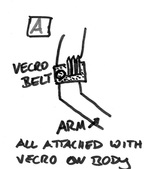
Concept 1
Belt attached devices
The idea here is to attach the devices for example with vecro to a (vecro) belt. Here the belt is around the arm. It could as well be around the waist. Around the arm would potentially be good for small devices. It would not work for the A4/letter sized notes.
The concept evolved in such a way that the belt idea was generalized. It could be fitted around the arm or the waist. The concept testing here is about the idea of attaching things to a belt, instead of storing them inside a bag. Is it practical while running around and using the devices? Is it easy to store and retrieve things? Is it comfortable to wear the A4 (it is in fact an A4 board with the notes attached to it) on the body?
Prototyp is usable with different kinds of belt (personalization). Image 1 and 2 show two different belts. Image 3 shows belt used around waist and stores also the A4 notes board.
Belt attached devices
The idea here is to attach the devices for example with vecro to a (vecro) belt. Here the belt is around the arm. It could as well be around the waist. Around the arm would potentially be good for small devices. It would not work for the A4/letter sized notes.
The concept evolved in such a way that the belt idea was generalized. It could be fitted around the arm or the waist. The concept testing here is about the idea of attaching things to a belt, instead of storing them inside a bag. Is it practical while running around and using the devices? Is it easy to store and retrieve things? Is it comfortable to wear the A4 (it is in fact an A4 board with the notes attached to it) on the body?
Prototyp is usable with different kinds of belt (personalization). Image 1 and 2 show two different belts. Image 3 shows belt used around waist and stores also the A4 notes board.
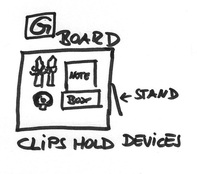
Concept 2
Board attached devices
Here, all devices are attached to a single tool board. This could stand or lean or lay where ever needed.
Questions would be: are devices easily attached? Would a trainer be comfortable with this style?
Prototyp is made out of white foam card board. It tests 2 different kinds of marker attachment, velcro for 2 and self built clips for 2 more. It also has a 'bag' to hold post-its and other things. Second image shows board leaned to wall and fitted with devices.
Board attached devices
Here, all devices are attached to a single tool board. This could stand or lean or lay where ever needed.
Questions would be: are devices easily attached? Would a trainer be comfortable with this style?
Prototyp is made out of white foam card board. It tests 2 different kinds of marker attachment, velcro for 2 and self built clips for 2 more. It also has a 'bag' to hold post-its and other things. Second image shows board leaned to wall and fitted with devices.
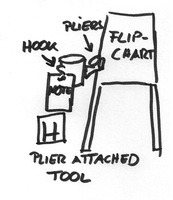
Concept 3
Plier attached bag with notes
This concept tries out the bag variant of storage. The bag can be attached with a strong plier to whatever. This could for example be the FlipChart as in the drawing.
The concept tests
a) the storage of smaller things inside the bag for example in small dedicated compartments.
b) the attachement of the notes outside the bag with a hook.
c) attachement to flipchart or chair or other things.
Prototype is a stiff bag with a hook attached through a plier. In image 3 the whole tool is attached to a flipchart sized foam cardboard with two pliers and a leather band. This way it can easily hang underneath or at any place along the flipchart. The band can be shortened just by putting the know shorter to the bag. This way it could be directly attached, close to the plier.
Plier attached bag with notes
This concept tries out the bag variant of storage. The bag can be attached with a strong plier to whatever. This could for example be the FlipChart as in the drawing.
The concept tests
a) the storage of smaller things inside the bag for example in small dedicated compartments.
b) the attachement of the notes outside the bag with a hook.
c) attachement to flipchart or chair or other things.
Prototype is a stiff bag with a hook attached through a plier. In image 3 the whole tool is attached to a flipchart sized foam cardboard with two pliers and a leather band. This way it can easily hang underneath or at any place along the flipchart. The band can be shortened just by putting the know shorter to the bag. This way it could be directly attached, close to the plier.
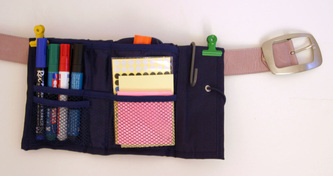
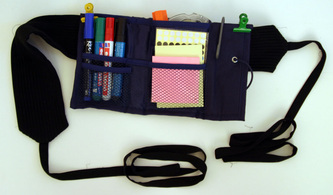
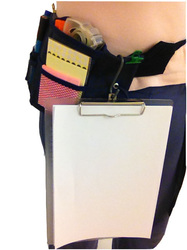
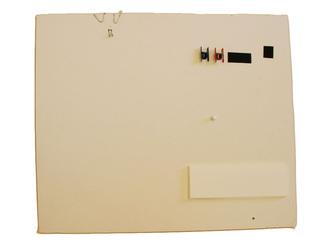
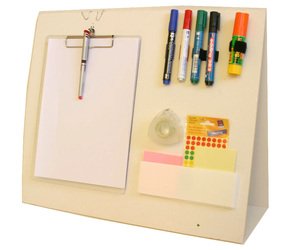
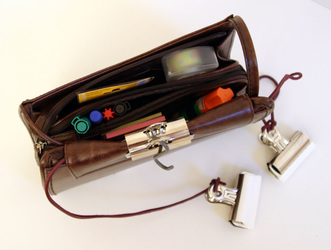
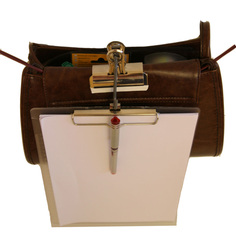
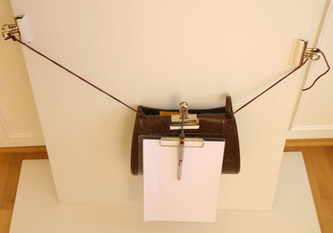
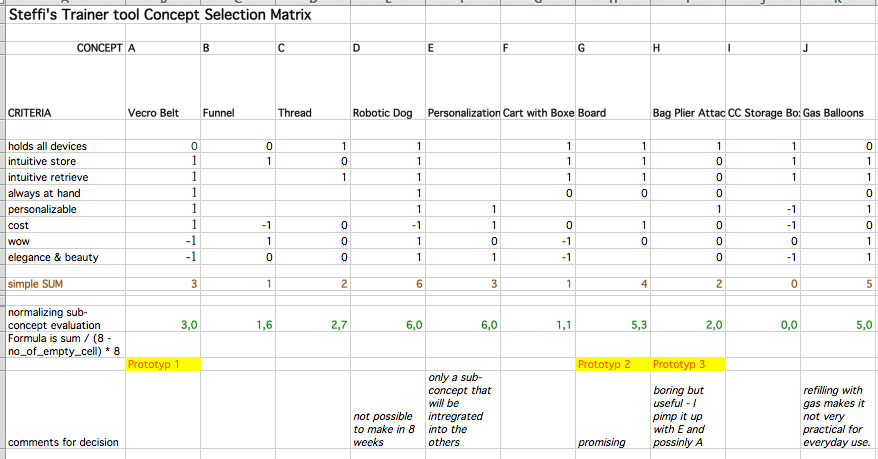
 RSS Feed
RSS Feed